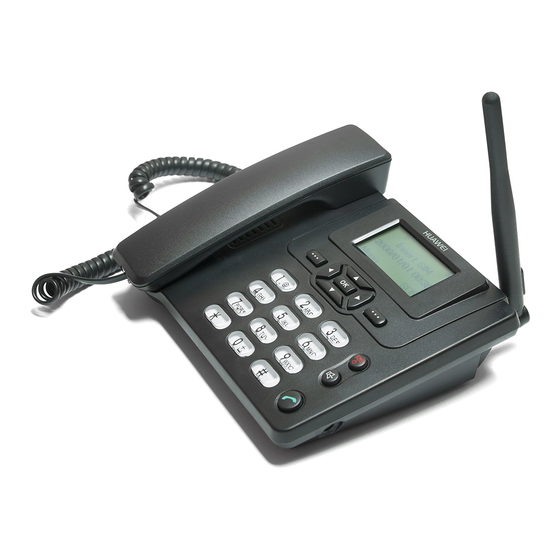Table of Contents
Advertisement
Advertisement
Table of Contents

Summary of Contents for Huawei ETS3125i
-
Page 1: User Guide
HUAWEI ETS3125i Fixed Wireless Terminal USER GUIDE... -
Page 2: Trademarks And Permissions
Huawei Technologies Co., Ltd reserves the right to change or modify any information or specifications contained in this manual without prior notice or obligation. -
Page 3: Front Overview
Introduction Note: The figures of the FWT (Fixed Wireless Terminal) are only for your reference, please refer color and shape to product. Front view Item Description Indoor antenna Receive signals Display Screen Display information Access the main menu in standby mode. Left soft key Select the option displayed on the lower left corner of the screen. -
Page 4: Screen Icons
Item Description Access the main Menu in standby mode. OK key Select the option displayed on the lower left corner of the display screen. End a call or reject an incoming call. End key Power on or off the FWT (by pressing and holding it). Return to the standby mode. -
Page 5: Using The Function Menu
Menu Tree Contacts Call history 1. Write message 1. Contacts 1. All Calls 2. Inbox 2. Create 2. Missed Calls 3. Outbox 3. Speed-dial 3. Received Calls 4. Drafts 4. Management 4. Dialed Calls 5. Voicemail 6. Cell Broadcast 7. Settings Settings Tools FM radio (Optional) -
Page 6: Installing The Battery
following figure. Make sure that the golden contact of the SIM card is facing downwards. Installing the Battery Power off the FWT and remove the power supply cable, and install the battery as shown. Make sure that the battery cord plug matches the battery jack. Do not insert the battery reversely. Using the Power Adapter and Charging the Battery 1. -
Page 7: Making A Call
Call Making a Call 1. In standby mode, enter a phone number. 2. Press to dial the number. 3. Press to end the call. Note: In standby mode, press to view the call history. Select a record and press dial this number. Select a contact from phone book and press to call this contact. -
Page 8: Input Modes
4. Press to reply, delete, or forward a short message, or call or save the phone number of a message. Input Modes Changing the Text Input Modes The indicator of the current text input mode is displayed on the screen. In the editing mode, press # Key to change the input mode. -
Page 9: Fm Radio (Optional)
FM Radio (Optional) FM Radio helps you conveniently listen to the FM radio programs. Select Menu > FM radio, and then press to switch the channel. Press to adjust the volume. You can select Opt. for the following operations. Switch Off: Switch the FM radio off. Channel List: Display a channel list. -
Page 10: Potentially Explosive Atmosphere
pacemaker, use the device on the opposite side of the pacemaker and do not carry the device in your front pocket. Some wireless devices may affect the performance of hearing aids. For any such problems, consult your service provider. Potentially Explosive Atmosphere Power off your device in any area with a potentially explosive atmosphere, and comply with all signs and instructions. -
Page 11: Battery And Charger
Accessories Use the accessories delivered only by the manufacturer. Using accessories of other manufacturers or vendors with this device model may invalidate any approval or warranty applicable to the device, result in the non-operation of the device, and cause danger. Battery and Charger Unplug the charger from the electrical plug and the device when not in use. -
Page 12: Emergency Call
Web site regularly for up-to-date information. EU Regulatory Conformance Hereby, Huawei Technologies Co., Ltd. declares that this device is in compliance with the essential requirements and other relevant provisions of Directive 1999/5/EC. For the declaration of conformity, visit the Web site www.huaweidevice.com/certification.












